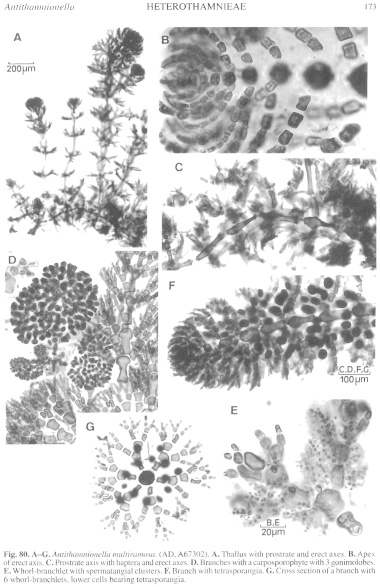|
|
|
|
|
|||||||||||
|
Electronic Flora of South Australia Species Fact Sheet
Phylum Rhodophyta – Order Ceramiales – Family Ceramiaceae – Tribe Heterothamnieae
Thallus (Fig. 80A) 1–2 (–3) mm high, forming small tufts on the hosts, with prostrate filaments bearing erect, simple or slightly branched, ecorticate axes, each axial cell bearing (5–) 6 (Fig. 80G) equally developed whorl-branchlets. Attachment by haptera on whorl-branchlets on prostrate filaments; epiphytic on the surface of Corallina officinalis and Haliptilon roseum. Structure. Apical cells 4–5 µm in diameter and L/D 0.8–1.2, with 3–6 small cells in a straight apex (Fig. 80B), then enlarging to mature axial cells 30–65 µm in diameter and L/D (1–) 1.5–2 (–2.5), with very thick walls. Prostrate axial cells (Fig. 80A, C) 40–55 µm in diameter and L/D 1.5–2, with the lower whorl-branchlets developing digitate haptera. Whorl-branchlets (Fig. 80A) in regular, evenly spaced whorls of 5 or 6, dense and overlapping near branch apices and separated below, complanate and usually slightly upwardly curved and facing the axis, 80–150 µm and (2–) 4–7 cells long (shorter on lower axes), basal cell unbranched (Fig. 80G), subdichotomous to alternately branched 1–3 times above with simple terminal rows of 2–4 cells; basal cells similar in size to mid cells, 20–30 µm in diameter and L/D 1–1.2, tapering over outer cells to apical cells 8–12 µm in diameter and L/D 1–1.5, with rounded ends; gland cells (Fig. 80G, E) frequent to profuse, 1–4 per whorl-branchlet on mid to upper branchlet cells, cut off from terminal or subterminal cells, touching the bearing cell and the end usually abutting the next cell above, ovoid, 15–20 µm in diameter. Lateral branches arising from the basal cell of a whorl-branchlet. Cells uninucleate; rhodoplasts discoid in small cells, becoming ribbon like in axial cells.
Reproduction: Gametophytes dioecious. Carpogonial branches borne on the basal cell of whorl-branchlets. Carposporophytes (Fig. 80D) terminal on lateral axes, with 1 (–2) rounded gonimolobes 180–240 µm across of ovoid carposporangia 15–20 µm across; lower whorl-branchlets or lateral branches from them extend further to form an involucre around the carposporophyte. Spermatangial clusters (Fig. 80E) branched, occurring on the upper side of basal and mid cells of whorl-branchlets.
Tetrasporangia (Fig. 80F, G) occur on basal and mid cells of whorl branchlets, situated adaxially above the branchlet, sessile, subspherical, 30–40 µm in diameter, decussately or tetrahedrally divided.
Type from Restless Point, West I., S. Aust., on Corallina officinalis, low eulittoral (Shepherd, 13.iii.1970); type collection in AD, A56301; holotype in GB.
Selected specimens: Greenly Beach, W coast of Eyre Pen., S. Aust., on Haliptilon roseum, low eulittoral (Parsons, 15.v.1968; AD, A32732). Restless Point, West. I., S. Aust., on Corallina officinalis, low eulittoral (Kildea, 27.x.1997; AD, A67302 - "Marine Algae of southern Australia" No. 399). Cape Willoughby, Kangaroo I., S. Aust., on C. officinalis, lower eulittoral (Womersley, 16.i.1946; AD, A13033).
Distribution: Greenly Beach, Eyre Pen., to West I., and Cape Willoughby, Kangaroo I., S. Australia.
Taxonomic notes: Antithamnionella multiramosa was placed in Antithamnionella by Athanasiadis but his reasons were not given; presumably they include the unbranched basal cells of whorl-branchlets, similar in size to the next cells, gland cells on normal whorl-branchlets, spermatangia on much branched clusters on whorl-branchlet cells, and subspherical tetrasporangia sessile on lower and mid cells of the whorl-branchlets. It is doubtful if A. multiramosa, with its regular whorls of 5 or 6 whorl-branchlets, much branched spermatangial clusters, and short series of subapical cells, is correctly placed here.
A. multiramosa is superficially similar to Perithamnion muelleri but differs in having distinct adaxial spermatangial clusters whereas the latter has spermatangia developed by continued divisions of terminal whorl-branchlet cells; the basal cells of whorl-branchlets are also branched in P. muelleri but unbranched in A. multiramosa.
References:
ATHANASIADIS, A. (1996). Morphology and classification of the Ceramioideae (Rhodophyta) based on phylogenetic principles. Opera Botanica No. 128, pp. 1–216.
The Marine Benthic Flora of Southern Australia Part IIIC complete list of references.
Publication:
Womersley, H.B.S. (24 December, 1998)
The Marine Benthic Flora of Southern Australia
Rhodophyta. Part IIIC. Ceramiales – Ceramiaceae, Dasyaceae
©State Herbarium of South Australia, Government of South Australia
Illustration in Womersley Part IIIA, 1998: FIG. 80.

Figure 80 enlarge
Fig. 80. A–G. Antithamnionella multiramosa. (AD, A67302). A. Thallus with prostrate and erect axes. B. Apex of erect axis. C. Prostrate axis with haptera and erect axes. D. Branches with a carposporophyte with 3 gonimolobes. E. Whorl-branchlet with spermatangial clusters. F. Branch with tetrasporangia. G. Cross section of a branch with 6 whorl-branchlets. lower cells bearing tetrasporangia.

|
Email Contact: State Herbarium of South Australia |

|